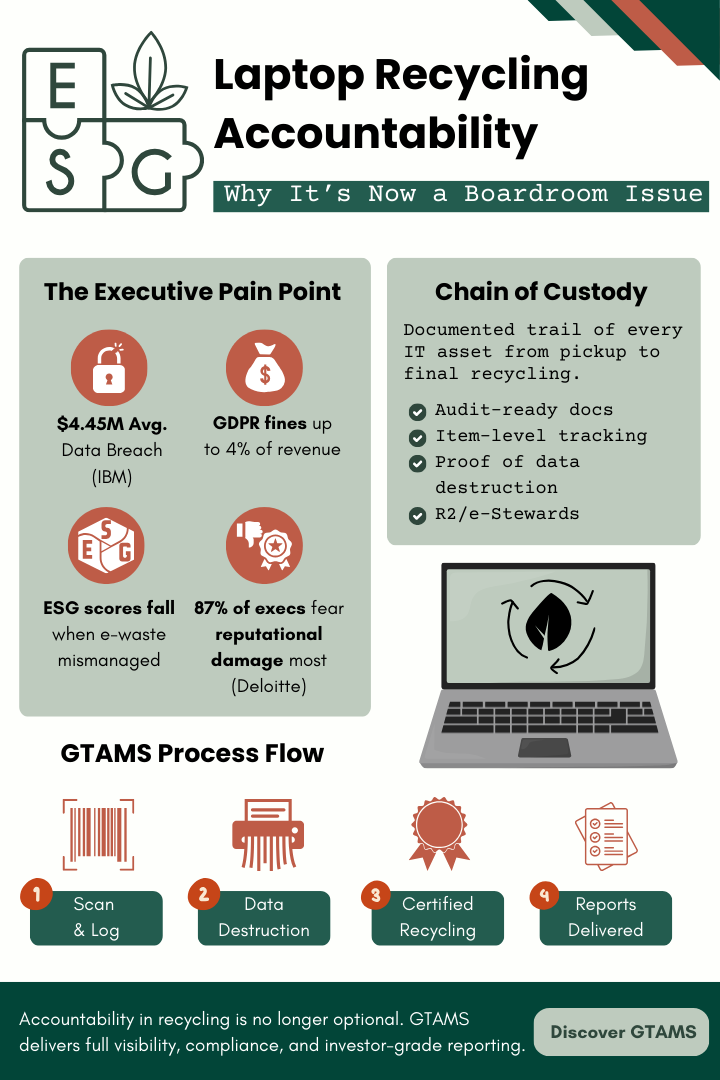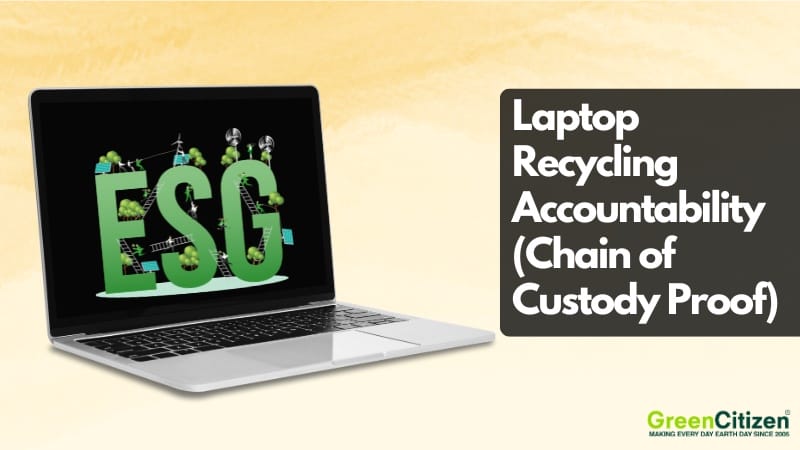Every year, Bay Area businesses retire tens of thousands of laptops during IT refresh cycles. For executives, this isn’t just an operational step — it’s a board-level risk. Improper laptop disposal can trigger data breaches, regulatory penalties, ESG compliance failures, and reputational damage.
Many companies assume that using a “certified recycler” is enough. In reality, once devices leave your office, visibility often disappears. Without chain of custody, laptops may be shipped overseas, resold with sensitive data still inside, or processed with no proof of compliance.
And when regulators, auditors, or investors ask for evidence, “we trusted our recycler” won’t hold up.
That’s why laptop recycling accountability is now non-negotiable. Chain of custody tracking, item-level reporting, and certified downstream partners define the new standard for corporate laptop recycling.
In the Bay Area, GreenCitizen’s GTAMS delivers exactly this — a system that ensures complete transparency and verifiable proof that every laptop is recycled responsibly.
Key Takeaway: Why Laptop Recycling Accountability Matters
Bay Area businesses can’t afford blind spots in laptop recycling. Without a verifiable chain of custody, the risks multiply — data breaches, regulatory fines, ESG score damage, and reputational fallout. GTAMS ensures full laptop recycling accountability with itemized, audit-ready reports that satisfy regulators, auditors, investors, and boards. For executives, it’s the gold standard of secure, compliant disposal.
The Executive Pain Point: Where Do Old Laptops Really Go?
When a company decommissions laptops, the risk doesn’t end when the devices leave the building. In fact, that’s when the biggest liabilities begin.
Where do old laptops go if not tracked? Too often, they’re exported overseas, resold with sensitive data still inside, or dumped in landfills without proof of compliance.

Here’s what that means for your business:
- Data breaches: How much does a data breach cost a business? IBM’s 2025 report puts the global average at $4.45 million per incedent. For regulated industries, costs are far higher. One untracked laptop can expose financials, customer data, or intellectual property.
- Compliance fines: Regulators under GDPR, CCPA, and California’s e-waste laws are tightening oversight. In 2023 alone, U.S. regulators issued millions in penalties for mishandled electronic waste. Your organization—not the recycler—bears the liability.
- ESG scoring: Investors now expect verifiable evidence of responsible IT asset disposition. Laptops showing up in overseas dumpsites can undercut ESG ratings and weaken investor trust.
- PR fallout: Media exposure of toxic waste or leaked data can undo years of brand reputation building in a single news cycle.
⚠️ The problem is clear: “using a recycler” isn’t enough. Without a verifiable chain of custody, businesses lose visibility the moment devices are picked up. And what you can’t track, you can’t prove—to regulators, auditors, or your board.
Chain of Custody Explained: Why It Matters for IT Assets
In compliance terms, chain of custody is the documented trail that records where each asset has been, who handled it, and what actions were taken.
For IT assets like laptops, it’s the difference between proving responsible recycling and merely hoping it happened.
Why is chain of custody important for businesses?
A proper chain of custody provides:
- Audit-ready documentation for regulators, auditors, and ESG reporting.
- Item-level accountability, tracking each laptop by serial number or barcode.
- Proof of data destruction, with timestamps showing when and how drives were wiped or shredded, often aligned with DoD 5220.22-M or NIST 800-88 standards.
- Downstream verification, confirming certified R2 or e-Stewards partners—not unvetted brokers—handled final processing.
What happens without a chain of custody?
Businesses face a dangerous blind spot. Devices can “disappear” between pickup and final recycling. If they surface overseas or resold with intact data, your company—not the recycler—absorbs the liability.
✅ Chain of custody in IT asset disposition is the documented trail proving where each device has been, who handled it, and what actions were taken. It ensures audit-ready compliance, item-level tracking, verified data destruction, and downstream certification—protecting businesses from data breaches, fines, and ESG risks.
What Is GTAMS: GreenCitizen’s Chain of Custody System for IT Recycling
The GreenCitizen Total Accountability Management System (GTAMS) is designed to close the accountability gap in electronics recycling. It transforms recycling from a trust-based process into a verifiable, audit-ready system.
Here’s how it works:
- Item-level tracking: Each laptop is logged by barcode or serial number, creating a permanent record in the chain of custody.
- Data destruction verification: GTAMS ensures drives are wiped or destroyed in compliance with DoD and NIST 800-88 standards, eliminating guesswork about sensitive data.
- Certified downstream partners: All devices flow only to R2 and e-Stewards certified recyclers, preventing illegal exports or unverified disposal.
- Compliance and ESG reports: Executives receive itemized accountability reports that integrate easily into annual sustainability disclosures and compliance audits.
For business leaders, GTAMS isn’t just a recycling tool—it’s a strategic safeguard:
- CIOs gain proof of cybersecurity controls.
- CFOs reduce liability exposure and avoid hidden compliance costs.
- CSOs and ESG leaders get verifiable sustainability reporting that strengthens investor and stakeholder confidence.
👉 In short, GTAMS transforms electronics recycling from an operational afterthought into a governance-level assurance system—the gold standard for Bay Area businesses seeking full accountability.
Case Study: The Difference Laptop Recycling Accountability Makes
A Deloitte survey found that 87% of executives see reputational risk as more damaging than regulatory fines — and improper IT disposal is a direct trigger. Pair that with repeated cases of U.S. recyclers exporting e-waste to Africa and Southeast Asia, and the liability gap becomes clear.
Now imagine two San Francisco tech companies, both refreshing 500 laptops.
Company A (no accountability system):
- Chooses a low-cost recycler without verifiable tracking.
- Six months later, photos appear online of their branded laptops dumped in Ghana.
- Serial numbers are visible. Regulators launch an investigation.
- Media brands it “greenwashing,” ESG scores plummet, and investor trust erodes.
- Result: reputational damage that far outweighs any compliance fine.
Company B (using GTAMS):
- Each laptop scanned, logged, and tracked in the GTAMS platform.
- Certified R2/e-Stewards partners handle downstream processing.
- The IT director receives a serialized accountability report.
- When ESG auditors request proof, the company produces a clean log showing full compliance.
- Result: transparency for investors, compliance for regulators, and reputational risk neutralized.
⚡ Takeaway: In an era of rising ESG scrutiny and tightening data regulations, accountability systems like GTAMS aren’t “nice to have.” They are a shield against reputational damage, financial loss, and compliance failures.
Regulatory and ESG Alignment: Staying Ahead of Compliance
The regulatory environment around IT asset disposal is only getting stricter. What was once considered “good practice” is rapidly becoming mandatory governance.
- California e-waste laws prohibit disposing of laptops and other electronics in landfills, holding businesses accountable for proper recycling.
- Data protection rules like GDPR and CCPA require organizations to prove that personal or customer data is destroyed securely — laptops without proof of erasure are a compliance risk.
- ESG disclosure trends from the SEC and global frameworks are pushing companies to provide verifiable evidence of sustainable practices, including how they manage end-of-life IT equipment.
This is where GTAMS reports give executives an edge. Every laptop recycled is logged, tracked, and certified with itemized documentation that feeds directly into compliance audits and ESG reports. It’s tangible proof that a company is managing risk, protecting customer data, and meeting sustainability commitments.
And with regulations tightening globally, adopting a system like GTAMS isn’t just about today’s compliance — it’s future-proofing against tomorrow’s legal and investor expectations.
Accountability in Recycling Is No Longer Optional
For Bay Area businesses, retiring laptops isn’t just an IT chore — it’s a governance issue. Data protection, regulatory compliance, ESG performance, and corporate reputation all hinge on what happens after devices leave your office. Without a verifiable chain of custody, the risks are real and the costs can be staggering.
GreenCitizen’s GTAMS gives decision makers the confidence that every laptop is tracked, processed responsibly, and documented with audit-ready proof. From secure pickup to certified recycling partners, GTAMS provides the gold standard of accountability — exactly what regulators, investors, and boards now demand.
Executives can’t afford blind spots in the recycling process. With GTAMS, accountability isn’t an afterthought — it’s built into every step.
